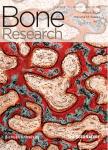PGE2 activates EP4 in subchondral bone osteoclasts to regulate osteoarthritis
PGE2 activates EP4 in subchondral bone osteoclasts to regulate osteoarthritis作者机构:Yangzhi Rehabilitation Hospital(Sunshine Rehabilitation Centre)Tongji University School of MedicineShanghaiPR China Shanghai Key Laboratory of Regulatory BiologyInstitute of Biomedical Sciences and School of Life SciencesEast China Normal UniversityShanghaiPR China Departments of Orthopaedic Surgery and Biomedical Engineering and Institute of Cell EngineeringThe Johns Hopkins University School of MedicineBaltimoreMDUSA Department of Oncology and MetabolismThe University of SheffieldSheffieldUK
出 版 物:《Bone Research》 (骨研究(英文版))
年 卷 期:2022年第10卷第2期
页 面:378-393页
核心收录:
学科分类:1002[医学-临床医学] 100210[医学-外科学(含:普外、骨外、泌尿外、胸心外、神外、整形、烧伤、野战外)] 10[医学]
基 金:supported by grants from the National Key Research and Development Program of China (2020YFC2002800 to J.L. and 2018YFC1105102 to J.L.) the National Natural Science Foundation of China (91949127, 92168204 to J.L.) the Fundamental Research Funds for the Central Universities (22120210586)
主 题:osteoclast homeostasis PGE2
摘 要:Prostaglandin E2(PGE2), a major cyclooxygenase-2(COX-2) product, is highly secreted by the osteoblast lineage in the subchondral bone tissue of osteoarthritis(OA) patients. However, NSAIDs, including COX-2 inhibitors, have severe side effects during OA treatment. Therefore, the identification of novel drug targets of PGE2 signaling in OA progression is urgently needed. Osteoclasts play a critical role in subchondral bone homeostasis and OA-related pain. However, the mechanisms by which PGE2 regulates osteoclast function and subsequently subchondral bone homeostasis are largely unknown. Here, we show that PGE2 acts via EP4 receptors on osteoclasts during the progression of OA and OA-related pain. Our data show that while PGE2 mediates migration and osteoclastogenesis via its EP2 and EP4 receptors, tissue-specific knockout of only the EP4 receptor in osteoclasts(EP4 Lys M) reduced disease progression and osteophyte formation in a murine model of OA. Furthermore, OA-related pain was alleviated in the EP4 Lys M mice, with reduced Netrin-1 secretion and CGRP-positive sensory innervation of the subchondral bone. The expression of plateletderived growth factor-BB(PDGF-BB) was also lower in the EP4 Lys Mmice, which resulted in reduced type H blood vessel formation in subchondral bone. Importantly, we identified a novel potent EP4 antagonist, HL-43, which showed in vitro and in vivo effects consistent with those observed in the EP4 Lys Mmice. Finally, we showed that the Gαs/PI3 K/AKT/MAPK signaling pathway is downstream of EP4 activation via PGE2 in osteoclasts. Together, our data demonstrate that PGE2/EP4 signaling in osteoclasts mediates angiogenesis and sensory neuron innervation in subchondral bone, promoting OA progression and pain, and that inhibition of EP4 with HL-43 has therapeutic potential in OA.



